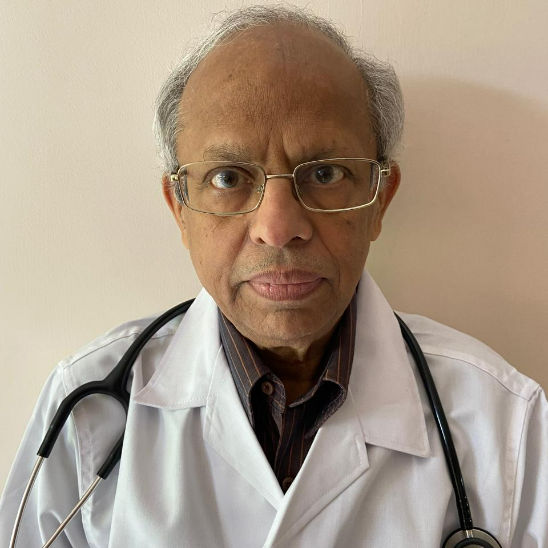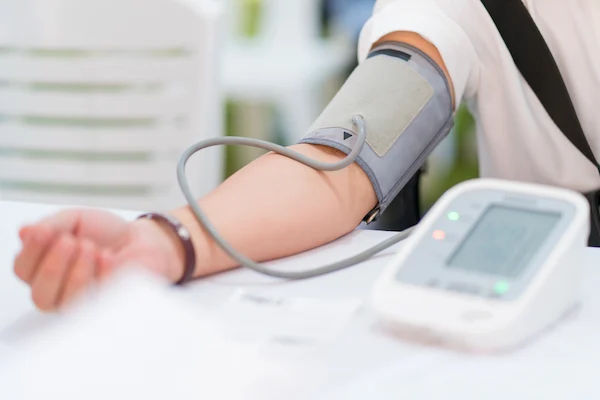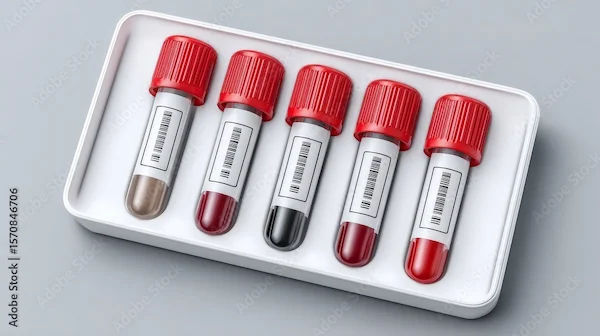Blood Clot Symptoms and Causes
Learn to recognise the symptoms and causes of blood clots, understand risk factors, and know when to seek medical attention.


Introduction
A blood clot is your body's essential first responder, rushing to seal a wound and stop bleeding. But what happens when this vital process goes awry? When a clot forms unnecessarily inside a vein or artery, it can transform from a lifesaver into a serious medical threat. Understanding the signs of a blood clot and what causes them is crucial for your health. This article will guide you through the common symptoms like swelling, pain, and redness and delve into the underlying causes, from prolonged immobility to genetic factors. We’ll break down the risks, explain how clots are treated, and provide actionable advice on prevention. Knowing these signs could make all the difference. If you experience symptoms that concern you, consulting a doctor online with Apollo24|7 can provide immediate, professional guidance.
What is a Blood Clot? The Good, The Bad, and The Dangerous
A blood clot, or thrombus, is a gel-like mass formed by platelets and fibrin in the blood to prevent bleeding. Its role is fundamentally protective, but its location and timing determine whether it's beneficial or harmful.
When Clotting is Normal: Healing and Protection
Haemostasis is the process of healthy clotting. When you get a cut, platelets stick together at the site to form a plug. Proteins in your blood plasma, called clotting factors, then create a mesh of fibrin strands that strengthens the platelet plug, forming a stable clot that stops blood loss and begins the healing process. This is a perfectly normal and necessary bodily function.
When Clotting Becomes Dangerous: Thrombosis and Embolism
Problems arise when a clot forms inside a blood vessel without any injury. This is called thrombosis. An even more dangerous situation occurs if all or part of that clot breaks free and travels through the bloodstream. This wandering clot is known as an embolus. It can lodge itself in critical organs, blocking blood flow and oxygen, which can lead to tissue damage, organ failure, or even death. This is what causes events like a pulmonary embolism (PE) or an ischemic stroke.
Consult a Haematologist for the best advice
Common Signs and Symptoms of a Blood Clot by Location
The symptoms of a blood clot depend almost entirely on where it is located in the body. Recognising these signs is the first step toward seeking help.
Deep Vein Thrombosis (DVT) in the Legs or Arms
Deep Vein Thrombosis (DVT) occurs when a clot forms in a major vein, usually deep within the leg (thigh or calf). It can also occur in the arm.
What Does a Blood Clot in the Leg Feel Like?
The symptoms of a DVT are often localised to the affected limb:
- Swelling: Often in one leg only, and it may seem sudden.
- Pain: Can feel like a cramp, soreness, or a sharp ache, typically starting in the calf.
- Warmth: The skin around the painful area may feel warmer than the surrounding skin.
- Redness or Discolouration: The skin may appear red, purple, or bluish.
- Visible Surface Veins: Veins near the skin's surface might become more prominent.
It's important to note that sometimes a DVT can occur with very minor symptoms or even none at all, making awareness of risk factors critical.
Pulmonary Embolism (PE) in the Lungs
A Pulmonary Embolism is a life-threatening medical emergency that occurs when a clot (often from a DVT in the legs) travels to the lungs and blocks a pulmonary artery. Symptoms require immediate medical attention:
- Sudden Shortness of Breath: This is the most common symptom.
- Sharp, Stabbing Chest Pain: Often worse when breathing deeply, coughing, or bending over.
- Rapid Heart Rate: (Tachycardia)
- Cough: May produce bloody or blood-streaked mucus.
- Lightheadedness, Dizziness, or Fainting: Due to a sudden drop in blood pressure.
Other Critical Locations: Heart, Brain, and Kidneys
Heart (Coronary Artery): A clot here can cause a heart attack, with symptoms like chest pressure, pain radiating to the jaw or arm, sweating, and nausea.
Brain (Cerebral Artery): A clot causing an ischemic stroke leads to sudden numbness/weakness (especially on one side), confusion, trouble speaking, and loss of coordination.
Abdomen/Kidneys: Can cause severe abdominal pain, nausea, vomiting, and blood in the urine.
What Leads to a Blood Clot? Understanding the Root Causes
The formation of a harmful clot isn't random; it's typically triggered by a combination of factors described by a medical principle known as Virchow's Triad.
The Classic Model: Virchow's Triad
This century-old model remains relevant and identifies three primary categories of causes that contribute to thrombosis.
Venous Stasis (Slowed Blood Flow)
When blood flow slows down or pools, it gives clotting factors more time to accumulate and form a clot. Common causes include:
- Prolonged Immobility: Long-haul flights, bed rest after surgery or illness, long car rides.
- Paralysis
- Atrial Fibrillation: An irregular heartbeat that causes blood to pool in the heart's chambers.
Hypercoagulability (Increased Clotting Tendency)
This refers to a state where the blood is more prone to clotting than usual. This can be:
- Genetic: Inherited disorders like Factor V Leiden mutation or Prothrombin gene mutation.
- Acquired: Cancer, smoking, dehydration, pregnancy, postpartum period, and certain medications (like hormone replacement therapy or birth control pills).
Endothelial Injury (Damage to Blood Vessel Lining)
The inner wall of a blood vessel is smooth and designed to prevent clotting. If it's damaged, it provides a rough surface for platelets to cling to and start the clotting process. Causes include:
- Surgery or Trauma: Especially major surgery on the hips, knees, or abdomen.
- Inflammation: From conditions like vasculitis or phlebitis.
- Catheters or IV Lines: Can irritate the vessel wall.
Key Risk Factors That Increase Your Chances
Certain conditions, behaviours, and genetics can significantly elevate your risk of developing a blood clot.
Medical Conditions and Procedures
- Recent Major Surgery or Hospitalisation: This is a leading risk factor, combining immobility and potential vessel injury.
- Cancer and Cancer Treatments: Some cancers increase proteins that clot blood, and chemotherapy can damage vessel linings.
- Heart and Lung Diseases: Heart failure, COPD, and atrial fibrillation.
- Previous History of DVT/PE: Having one clot puts you at higher risk for another.
- Pregnancy and Postpartum: The risk is increased due to hormonal changes and pressure on veins from the growing uterus.
- COVID-19: The infection can cause inflammation and damage to blood vessels, significantly increasing clot risk.
Lifestyle and Genetic Factors
Prolonged Sitting or Bed Rest: Includes long-distance travel ("economy class syndrome").
- Smoking: Damages blood vessels and affects circulation.
- Obesity: Increases pressure in the veins of the pelvis and legs.
- Age: Risk increases after age 60, though clots can occur at any age.
- Family History: Indicates a possible inherited blood clotting disorder.
- Estrogen-Based Medications: Including birth control pills and hormone therapy.
If you have multiple risk factors and are planning a major surgery, discussing preventive measures with your doctor is essential. Apollo24|7 offers a convenient home collection for tests like D-Dimer to help monitor your health from home.
How Are Blood Clots Diagnosed and Treated?
If a blood clot is suspected, prompt diagnosis and treatment are critical.
Diagnostic Tests: From Ultrasound to D-Dimer
- Ultrasound: The most common test for diagnosing DVT. It uses sound waves to create images of blood flow in the veins.
- D-Dimer Blood Test: Measures a substance released when a clot breaks up. A negative test can often rule out a recent clot.
- CT or MRI Scans: Used to visualize clots in the lungs (CT pulmonary angiogram) or other areas like the abdomen or brain.
- VQ Scan: A specialised test used to check for lung clots.
Treatment Options: Anticoagulants and Thrombolytics
The primary goal is to stop the clot from growing, prevent it from traveling, and reduce the chance of future clots.
- Anticoagulants (Blood Thinners): Medications like warfarin, heparin, or direct oral anticoagulants (DOACs like apixaban, rivaroxaban) don't "thin" the blood or dissolve the clot; they prevent new clots from forming and allow the body's natural systems to dissolve the existing one over time.
- Thrombolytics (Clot Busters): These powerful, IV-administered drugs are used in life-threatening situations (like a massive PE or stroke) to quickly dissolve a clot. They carry a higher risk of bleeding.
- Compression Stockings: Worn on the legs to help prevent swelling and post-thrombotic syndrome after a DVT.
Get Your Health Assessed
Preventing Blood Clots: Proactive Steps You Can Take
Many blood clots are preventable with conscious effort, especially if you have known risk factors.
- Stay Active: Move your legs and walk around regularly. If sitting for long periods (travel, desk job), flex your ankles, stretch your calves, and get up hourly.
- Hydrate: Drink plenty of water, especially when travelling, to prevent your blood from thickening.
- Manage Weight: Maintain a healthy weight to reduce pressure on your veins.
- Quit Smoking: This is one of the most significant changes you can make for vascular health.
- Understand Your Risk: Talk to your doctor about your personal risk, especially before surgeries or if starting new medications.
- Compression: Consider wearing compression socks during long flights if you are at risk.
- Post-Surgery Mobility: Follow your doctor's instructions to get moving as soon as it is safe after a procedure.
Conclusion
Recognising the signs of a blood clot and understanding what leads to them is a powerful tool in safeguarding your health. While the thought of a blood clot can be frightening, knowledge dispels fear and enables action. By being aware of the symptoms, like unexplained leg pain or sudden breathlessness, and your personal risk factors, you are empowered to seek help early. Remember, a blood clot is a medical condition that is highly treatable when caught in time. Adopting preventative lifestyle habits, especially during periods of increased risk like long travel or recovery from surgery, can significantly reduce your chances of developing one. Listen to your body, understand the risks, and don't hesitate to seek professional medical advice. If you experience any sudden or severe symptoms suggestive of a blood clot, seek emergency care immediately. For a non-emergency evaluation of your risk factors or follow-up care, you can consult a doctor online with Apollo24|7.
Consult a Haematologist for the best advice
Consult a Haematologist for the best advice

Dr.sanchayan Mandal
Medical Oncologist
17 Years • MBBS, DrNB( MEDICAL ONCOLOGY), DNB (RADIOTHERAPY),ECMO. PDCR. ASCO
Kolkata
Dr. Sanchayan Mandal Oncology Clinic, Kolkata
Dr. Velu Nair
Haematologist
36 Years • MBBS, MD (Med.), FRCP, FACP, FAMS, FICP, FIACM, FUICC, FISHTM
Ahmedabad
Apollo Hospitals Gandhinagar, Ahmedabad
(25+ Patients)

Dr Abilash Jain
General Physician/ Internal Medicine Specialist
12 Years • MBBS,DNB(FM),MNAMS,FIAMS,CCGMG(GERIATRICS),DGM (GERIATRICS),PGCD(DIABETES,BOSTON UNIVERSITY),FID(DIABETICS UK)CCEPC(PALLIATIVE CARE),CCCC(CRITICAL CARE)
Visakhapatnam
Apollo Clinic Vizag, Visakhapatnam

Dr. Ramalinga Reddy
General Physician
5 Years • MBBS MD General medicine
Bengaluru
PRESTIGE SHANTHINIKETAN - SOCIETY CLINIC, Bengaluru

Dr. E Prabhakar Sastry
General Physician/ Internal Medicine Specialist
40 Years • MD(Internal Medicine)
Manikonda Jagir
Apollo Clinic, Manikonda, Manikonda Jagir
(150+ Patients)
Consult a Haematologist for the best advice

Dr.sanchayan Mandal
Medical Oncologist
17 Years • MBBS, DrNB( MEDICAL ONCOLOGY), DNB (RADIOTHERAPY),ECMO. PDCR. ASCO
Kolkata
Dr. Sanchayan Mandal Oncology Clinic, Kolkata
Dr. Velu Nair
Haematologist
36 Years • MBBS, MD (Med.), FRCP, FACP, FAMS, FICP, FIACM, FUICC, FISHTM
Ahmedabad
Apollo Hospitals Gandhinagar, Ahmedabad
(25+ Patients)

Dr Abilash Jain
General Physician/ Internal Medicine Specialist
12 Years • MBBS,DNB(FM),MNAMS,FIAMS,CCGMG(GERIATRICS),DGM (GERIATRICS),PGCD(DIABETES,BOSTON UNIVERSITY),FID(DIABETICS UK)CCEPC(PALLIATIVE CARE),CCCC(CRITICAL CARE)
Visakhapatnam
Apollo Clinic Vizag, Visakhapatnam

Dr. Ramalinga Reddy
General Physician
5 Years • MBBS MD General medicine
Bengaluru
PRESTIGE SHANTHINIKETAN - SOCIETY CLINIC, Bengaluru

Dr. E Prabhakar Sastry
General Physician/ Internal Medicine Specialist
40 Years • MD(Internal Medicine)
Manikonda Jagir
Apollo Clinic, Manikonda, Manikonda Jagir
(150+ Patients)
Get Your Health Assessed
₹1250(₹3125)60% off
More articles from General Medical Consultation
Frequently Asked Questions
Can a blood clot go away on its own?
Yes, your body has a natural system (fibrinolysis) to break down clots over time. However, a dangerous clot requires medical treatment with anticoagulants to prevent it from growing or breaking free while your body dissolves it.
What are the first signs of a blood clot in your leg?
The earliest signs are often a persistent cramping or soreness, usually in the calf, accompanied by swelling in one leg that doesn't go away with elevation. The skin may also feel warm and look reddened.
How can I check myself for blood clots at home?
You cannot reliably self-diagnose a blood clot. While you can look for symptoms like swelling and pain, many clots have minimal symptoms. If you suspect a DVT based on risk factors and symptoms, it is essential to see a doctor for proper testing like an ultrasound.
How long can you have a blood clot without knowing?
It's possible to have a small DVT for weeks without obvious symptoms. Some people only discover they had one after it causes a complication like a Pulmonary Embolism. This is why awareness of subtle signs and risk factors is so important.
Are there any natural remedies to dissolve blood clots?
No. While some foods like garlic and ginger have mild anticoagulant properties, they are nowhere near powerful enough to treat an acute, dangerous blood clot. Medical treatment with prescribed anticoagulants is necessary to manage the situation safely.




